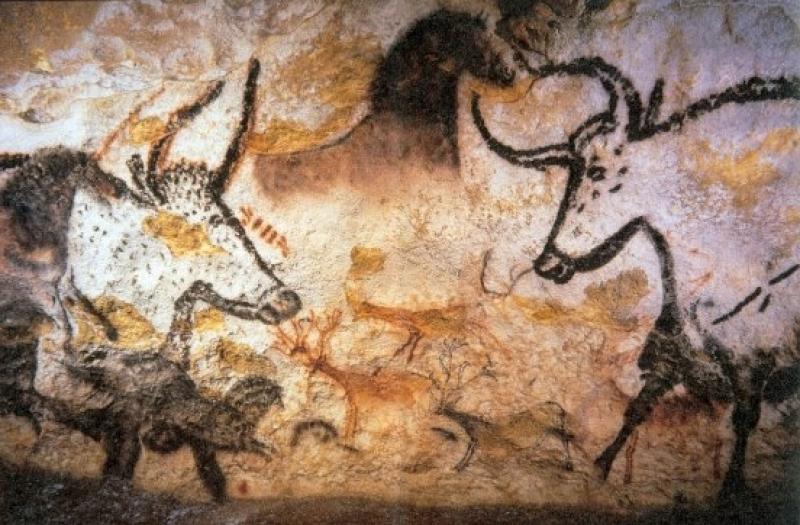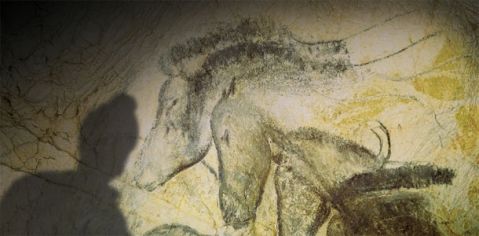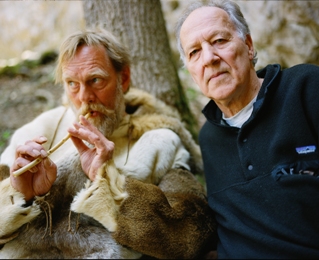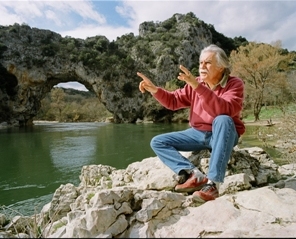Cave of Forgotten Dreams | reviews, news & interviews
Cave of Forgotten Dreams
Cave of Forgotten Dreams
Werner Herzog trains a 3D camera on miraculous palaeolithic cave paintings

The first thing that must be said is the paintings, captured by Herzog and his crew, are breathtaking beyond description. Among the animals depicted with remarkable clarity are mammoths, horses, bison, rhinoceros, ibex, lions and the only known instance of a panther in paleolithic art. There is even a giant creepy crawly clambering up one wall. And the cave itself is a mini-miracle of preserved evidence.
Herzog has never been a film-maker to swim downstream, but his decision to go with the flow and use the latest 3D technology is inspired. Often deployed as a lazy afterthought in more sensationalist ventures, here Herzog’s camera scopes the sinuous curves and tumescent lumps of the cave walls, or creeps across its calcified floor, like a bomb-detection device, sensitive to contour, alive to the nuances of space.
Cave of Forgotten Dreams feels like a companion piece to Encounters at the End of the World, his visit to Antarctica from which he brought back astonishing images of marine life filmed in a hidden world under the sea ice. Here, as there, we get Herzog inserting himself on voiceover duties. He makes for a deadpan messenger, apparently (though you’re never quite sure) deaf to his own absurdity. His speculations as he obsessively hunts for meaning, for connection, lead him up some blind alleyways which, frankly, this film could do without – never more than in a bathetic coda which takes him to a nearby botanic garden where albino crocodiles swim in pools. (Don't ask. You are urged to leave before this bit, so that your last memory is, fittingly, of a human handprint from 30 millennia ago.)
But as it’s Herzog bringing us this story, we must learn to live with these interventions. Sometimes the cave seems to be fighting back. At one point he asks everyone, scientists and crew, to keep quiet so we can listen out for the echo of long-dead heartbeats. The camera pans across from Herzog looking sagacious to a tall stalagmite, apparently giving one of the great poets of modern cinema a one-fingered salute.
Herzog’s career in documentary bleeds seamlessly into his interest in the freaks, visionaries and weirdos who skitter and howl across the screen in Fitzcarraldo, The Enigma of Kaspar Hauser and Nosferatu the Vampyre. Here he works hard to unearth a quirky romanticism among the scientists who spend as much time as is allowed in the cave. A young archaeologist, he is delighted to discover, used to work in the circus. “Lion-tamer?” Herzog asks hopefully. Turns out he was just a bog-standard unicyclist. He also meets up with a master perfumer, an archetypal Herzogian eccentric who hunts for hidden cave openings by smell. Others give rein to their own sensory imagination: one of the cave’s curators claims to be able to hear the thud of clashing rhino horns or the gallop of hooves under a horse herd.

Another tic of Herzog is a form of solipsism - to find in the cave paintings a conjunction with the art form to which he has devoted his life. Thus the bison with eight legs suggesting movement is “like frames in an animated film”. The shadows cast by humans on the wall – now with low-heat lights (pictured above), but once upon a time with fire – evokes for him a memory of Fred Astaire dancing with huge silhouetted projections. One analogy he misses is with the glistening bulbous accretions growing on the cave floor, which resemble nothing so much as special effects from Ridley Scott’s Alien.
 There isn’t quite enough material from the Chauvet cave to fill a whole film, so Herzog diverts to Swabia in south-west Germany where evidence has been found of contemporaneous human life, including a pentatonic flute on which a fur-clad expert (pictured right with Herzog) plays “The Star-Spangled Banner”. There is also a demonstration of hunting weaponry (“I will try to show you how to kill a horse,” says a bearded expert, goofily). The 3D camera catches the wooden spear with flint blade jabbing threateningly through the screen.
There isn’t quite enough material from the Chauvet cave to fill a whole film, so Herzog diverts to Swabia in south-west Germany where evidence has been found of contemporaneous human life, including a pentatonic flute on which a fur-clad expert (pictured right with Herzog) plays “The Star-Spangled Banner”. There is also a demonstration of hunting weaponry (“I will try to show you how to kill a horse,” says a bearded expert, goofily). The 3D camera catches the wooden spear with flint blade jabbing threateningly through the screen.
You could more or less set your watch by the moment Herzog gets round to mentioning Picasso, who was stimulated by other paleolithic finds. You’d love to know what Leonardo, that obsessive student of anatomy and kinetic motion, would have made of it all – of the eyes of lions shining with intense vivacity, or a white horse with a coal-black head, or one bison whose mighty heft all but barges its way off the wall.
 The question arises of who these artists were. Herzog ponders all sorts of ideas about their spirituality, about the (to him) mystical Wagnerian landscape of the Ardèche gorge which features a river curling through a rocky arch (pictured right with French scientist). The title of the film itself feels like no more than a whimsical bit of Freudian editorialising. Were these products really the product of dreams? In the end, nobody knows anything other than what is supplied by the evidence. The archaeologists have concluded that no humans lived in the cave. A footprint of an eight-year-old boy has been preserved in close proximity to that of a wolf. Did the wolf kill the boy? Or were the prints left 5,000 years apart?
The question arises of who these artists were. Herzog ponders all sorts of ideas about their spirituality, about the (to him) mystical Wagnerian landscape of the Ardèche gorge which features a river curling through a rocky arch (pictured right with French scientist). The title of the film itself feels like no more than a whimsical bit of Freudian editorialising. Were these products really the product of dreams? In the end, nobody knows anything other than what is supplied by the evidence. The archaeologists have concluded that no humans lived in the cave. A footprint of an eight-year-old boy has been preserved in close proximity to that of a wolf. Did the wolf kill the boy? Or were the prints left 5,000 years apart?
Most intriguing of all is the thick cluster of palm prints left in a bright ochre pigment on the face of a rock. From a distance they look like a form of primitive pointillism. From close-up they resemble the work of yet another of Herzog’s obsessives. It’s as if the director has gone back 32 millennia to find himself looking in the mirror.
Explore topics
Share this article
The future of Arts Journalism
You can stop theartsdesk.com closing!
We urgently need financing to survive. Our fundraising drive has thus far raised £49,000 but we need to reach £100,000 or we will be forced to close. Please contribute here: https://gofund.me/c3f6033d
And if you can forward this information to anyone who might assist, we’d be grateful.

Subscribe to theartsdesk.com
Thank you for continuing to read our work on theartsdesk.com. For unlimited access to every article in its entirety, including our archive of more than 15,000 pieces, we're asking for £5 per month or £40 per year. We feel it's a very good deal, and hope you do too.
To take a subscription now simply click here.
And if you're looking for that extra gift for a friend or family member, why not treat them to a theartsdesk.com gift subscription?
more Film
 Blu-ray: The Sons of Great Bear
DEFA's first 'Red Western': a revisionist take on colonial expansion
Blu-ray: The Sons of Great Bear
DEFA's first 'Red Western': a revisionist take on colonial expansion
 Spinal Tap II: The End Continues review - comedy rock band fails to revive past glories
Belated satirical sequel runs out of gas
Spinal Tap II: The End Continues review - comedy rock band fails to revive past glories
Belated satirical sequel runs out of gas
 Downton Abbey: The Grand Finale review - an attemptedly elegiac final chapter haunted by its past
Noel Coward is a welcome visitor to the insular world of the hit series
Downton Abbey: The Grand Finale review - an attemptedly elegiac final chapter haunted by its past
Noel Coward is a welcome visitor to the insular world of the hit series
 Islands review - sunshine noir serves an ace
Sam Riley is the holiday resort tennis pro in over his head
Islands review - sunshine noir serves an ace
Sam Riley is the holiday resort tennis pro in over his head
 theartsdesk Q&A: actor Sam Riley on playing a washed-up loner in the thriller 'Islands'
The actor discusses his love of self-destructive characters and the problem with fame
theartsdesk Q&A: actor Sam Riley on playing a washed-up loner in the thriller 'Islands'
The actor discusses his love of self-destructive characters and the problem with fame
 Honey Don’t! review - film noir in the bright sun
A Coen brother with a blood-simple gumshoe caper
Honey Don’t! review - film noir in the bright sun
A Coen brother with a blood-simple gumshoe caper
 The Courageous review - Ophélia Kolb excels as a single mother on the edge
Jasmin Gordon's directorial debut features strong performances but leaves too much unexplained
The Courageous review - Ophélia Kolb excels as a single mother on the edge
Jasmin Gordon's directorial debut features strong performances but leaves too much unexplained
 Blu-ray: The Graduate
Post #MeToo, can Mike Nichols' second feature still lay claim to Classic Film status?
Blu-ray: The Graduate
Post #MeToo, can Mike Nichols' second feature still lay claim to Classic Film status?
 Little Trouble Girls review - masterful debut breathes new life into a girl's sexual awakening
Urska Dukic's study of a confused Catholic teenager is exquisitely realised
Little Trouble Girls review - masterful debut breathes new life into a girl's sexual awakening
Urska Dukic's study of a confused Catholic teenager is exquisitely realised
 Young Mothers review - the Dardennes explore teenage motherhood in compelling drama
Life after birth: five young mothers in Liège struggle to provide for their babies
Young Mothers review - the Dardennes explore teenage motherhood in compelling drama
Life after birth: five young mothers in Liège struggle to provide for their babies
 Blu-ray: Finis Terrae
Bleak but compelling semi-documentary, filmed on location in Brittany
Blu-ray: Finis Terrae
Bleak but compelling semi-documentary, filmed on location in Brittany
 Oslo Stories Trilogy: Sex review - sexual identity slips, hurts and heals
A quietly visionary series concludes with two chimney sweeps' awkward sexual liberation
Oslo Stories Trilogy: Sex review - sexual identity slips, hurts and heals
A quietly visionary series concludes with two chimney sweeps' awkward sexual liberation

Add comment